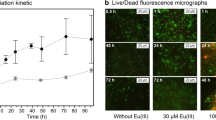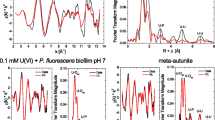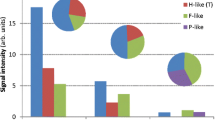Abstract
Pyoverdins, bacterial siderophores produced by ubiquitous fluorescent Pseudomonas species, have great potential to bind and thus transport actinides in the environment. Therefore, the influence of pyoverdins secreted by microbes on the migration processes of actinides must be taken into account in strategies for the risk assessment of potential nuclear waste disposal sites. The unknown interaction between curium(III) and the pyoverdins released by Pseudomonas fluorescens (CCUG 32456) isolated from the granitic rock aquifers at the Äspö Hard Rock Laboratory (Äspö HRL), Sweden, is the subject of this paper. The interaction between soluble species of curium(III) and pyoverdins was studied at trace curium(III) concentrations (3 × 10−7 M) using time-resolved laser-induced fluorescence spectroscopy (TRLFS). Three Cm3+—P. fluorescens (CCUG 32456) pyoverdin species, MpHqLr, could be identified from the fluorescence emission spectra, CmH2L+, CmHL, and CmL−, having peak maxima at 601, 607, and 611 nm, respectively. The large formation constants, log β121 = 32.50 ± 0.06, log β111 = 27.40 ± 0.11, and log β101 = 19.30 ± 0.17, compared to those of other chelating agents illustrate the unique complexation properties of pyoverdin-type siderophores. An indirect excitation mechanism for the curium(III) fluorescence was observed in the presence of the pyoverdin molecules.






Similar content being viewed by others
References
Albrecht-Gary AM, Blanc S, Rochel N, Abdallah M (1991) Pyoverdin and related siderophores: a physico-chemical study of the iron coordination mechanism. Inorg Biochem 43:143
Albrecht-Gary AM, Blanc S, Rochel N, Ocakatan AZ, Abdallah MA (1994) Bacterial iron transport: coordination properties of pyoverdine PaA, a peptidic siderophore of Pseudomonas aeruginosa. Inorg Chem 33:6391–6402
Binstead RA, Zuberbühler AD, Jung B (2004) SPECFIT Global Analysis System Version 3.0.35
Bouby M, Billard I, MacCordick J (1999) Selective behavior of the siderophore pyoverdine A towards UO2 2+, Th4+, U4+ and other cations. Czech J Phys 49:147–150
Bouby M, Billard I, MacCordick J (1998) Complexation of Th(IV) with the siderophore pyoverdine A. J Alloys Compd 271–273:206–210
Brainard JR, Strietelmeier BA, Smith PH, Langston-Unkefer PJ, Barr ME, Ryan RR (1992) Actinide binding and solubilization by microbial siderophores. Radiochim Acta 58–59:357–363
Budzikiewicz H (2004) Siderophores of the Pseudomonadaceae sensu stricto (fluorescent and non-fluorescent Pseudomonas spp.). Fortschr Chem Org Naturst 87:83–237
Carnall WT, Rajnak K (1975) Electronic energy level and intensity correlations in the spectra of the trivalent actinide aquo ions. II. Cm(III). J Chem Phys 63:3510–3514
Choppin GR, Thakur P, Mathur JN (2006) Complexation thermodynamics and structural aspects of actinide-aminopolycarboxylates. Coord Chem Rev 250:936–947
Edelstein NM, Klenze R, Fanghänel Th, Hubert S (2006) Optical properties of Cm(III) in crystals and solutions and their application to Cm(III) speciation. Coord Chem Rev 250:948–973
Jarvis NV, Hancock RD (1991) Some correlations involving the stability of complexes of transuranium metal ions and ligands with negatively charged oxygen donors. Inorg Chim Acta 182:229–232
Johnsson A, Arlinger J, Pedersen K, Ödegaard-Jensen A, Albinsson Y (2006) Solid–aqueous phase partitioning of radionuclides by complexing compounds excreted by subsurface bacteria. Geomicrobiol J 23:621–630
Kalinowski BE, Oskarsson A, Albinsson Y, Arlinger J, Ödegaard-Jensen A, Andlid T, Pedersen K (2004) Microbial leaching of uranium and other trace elements from shale mine tailings at Ranstad. Geoderma 122:177–194
Kalinowski BE, Johnsson A, Arlinger J, Pedersen K, Ödegaard-Jensen A, Edberg F (2006) Microbial mobilization of uranium from shale mine waste. Geomicrobiol J 23:157–164
Kersting A, Efured D, Finnegan D, Rokop D, Smith D, Thompson J (1999) Migration of plutonium in groundwater at the Nevada test site. Nature 397:56–59
Kimura T, Choppin GR (1994) Luminescence study on determination of the hydration number of Cm(III). J Alloys Compd 213–214:313–317
Lindqvist-Reis P, Klenze R, Schubert G, Fanghänel Th (2005) Hydration of Cm3+ in aqueous solution from 20 to 200°C: a time-resolved laser fluorescence spectroscopy study. J Phys Chem B 109:3077–3083
Meyer JM (2000) Pyoverdines: pigments, siderophores and potential taxonomic markers of fluorescent Pseudomonas species. Arch Microbiol 174:135–142
Meyer JM, Abdallah MA (1978) The fluorescent pigment of Pseudomonas fluorescens: biosysnthesis, purification and physicochemical properties. J Gen Microbiol 107:319–328
Moll H, Stumpf Th, Merroun M, Rossberg A, Selenska-Pobell S, Bernhard G (2004) Time-resolved laser fluorescence spectroscopy study on the interaction of Cm(III) with Desulfovibrio äspöensis DSM 10631T. Environ Sci Technol 38:1455–1459
Moll H, Johnsson A, Schäfer M, Glorius M, Pedersen K, Budzikiewicz H, Bernhard G (2007) Uranium(VI) complexation with pyoverdins secreted by a subsurface strain of Pseudomonas fluorescens. Geomicrobiol J (submitted)
Moll H, Geipel G, Bernhard G (2005) Complexation of Curium(III) by adenosine 5′-triphosphate (ATP): a Time-resolved Laser-induced Fluorescence Spectroscopy (TRLFS) study. Inorg Chim Acta 358:2275–2282
Moll H, Bernhard G (2007a) Complex formation of curium(III) with amino acids of different functionalities: l-threonine and O-phospho-l-threonine. J Coord Chem 60:1795–1807
Moll H, Bernhard G (2007b) The complexation of curium(III) with L2-aminobutyric acid investigated by time-resolved laser-induced fluorescence spectroscopy (TRLFS). J Radioanal Nucl Chem 274:603–608
Neu MP, Matonic JH, Ruggiero CE, Scott BL (2000) Structural characterization of a plutonium(IV) siderophore complex: single-crystal structure of Pu-Desferrioxamine E. Angew Chem Int Ed 39:1442–1444
Panak P, Klenze R, Kim JI, Wimmer H (1995) A study of intramolecular energy transfer in Cm(III) complexes with aromatic ligands by time-resolved laser fluorescence spectroscopy. J Alloys Compd 225:261–266
Pedersen K (1997) Microbial life in deep granitic rock. FEMS Microbiol Rev 20:399–414
Pedersen K (2005) Microorganisms and their influence on radionuclide migration in igneous rock environments. J Nucl Radiochem Sci 6:11–15
Powell PE, Cline GR, Reid CPP, Szaniszlo PJ (1980) Occurrence of hydroxamate siderophore iron chelators in soils. Nature 287:833–834
Rumynin VG, Konosavsky PK, Hoehn E (2005) Experimental and modelling study of adsorption–desorption processes with application to a deep-well injection radioactive waste disposal site. J Contam Hydrol 76:19–46
Schäfer H, Taraz K, Budzikiewicz H (1991) Zur Genese der amidisch an den Chromophor von Pyoverdinen gebundenen Dicarbonsäuren. Z Naturforsch 46c:398–406
Teintze M, Hossain MB, Barnes CL, Leong J, van der Helm D (1981) Structure of ferric pseudobactin, a siderophore from a plant growth promoting Pseudomonas. Biochemistry 20:6446–6457
Wang XK, Rabung Th, Geckeis H, Panak PJ, Klenze R, Fanghänel Th (2004) Effect of humic acid on the sorption of Cm(III) onto gamma-Al2O3 studied by the time-resolved laser fluorescence spectroscopy. Radiochim Acta 92:691–695
Whisenhunt DW, Neu MP, Hou Z, Xu J, Hoffman DC, Raymond KN (1996) Specific sequestering agents for the actinides. 29. Stability of the thorium(IV) complexes of desferrioxamine B (DFO) and three octadentate catecholate or hydroxypyridinonate DFO derivatives: DFOMTA, DFOCAMC, and DFO-1,2-HOPO. Comparative stability of the plutonium(IV) DFOMTA complex. Inorg Chem 35:4128–4136
Xiao R, Kisaalita WS (1995) Purification of pyoverdins of Pseudomonas fluorescens 2–79 by copper-chelate chromatography. Appl Environ Microbiol 61:3769–3774
Acknowledgements
This work was funded by BMWi under contract number 02E9985. The authors are indebted to the U.S. Department of Energy, Office of Basic Energy Sciences, for the use of 248Cm via the transplutonium element production facilities at Oak Ridge National Laboratory; 248Cm was made available as part of collaboration between FZD and the Lawrence Berkeley National Laboratory (LBNL).
Author information
Authors and Affiliations
Corresponding author
Rights and permissions
About this article
Cite this article
Moll, H., Johnsson, A., Schäfer, M. et al. Curium(III) complexation with pyoverdins secreted by a groundwater strain of Pseudomonas fluorescens . Biometals 21, 219–228 (2008). https://doi.org/10.1007/s10534-007-9111-x
Received:
Accepted:
Published:
Issue Date:
DOI: https://doi.org/10.1007/s10534-007-9111-x




